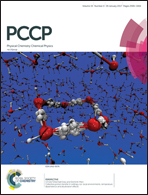Antiferromagnetic vs. non-magnetic ε phase of solid oxygen. Periodic density functional theory studies using a localized atomic basis set and the role of exact exchange†
Abstract
The question of the non-magnetic (NM) vs. antiferromagnetic (AF) nature of the ε phase of solid oxygen is a matter of great interest and continuing debate. In particular, it has been proposed that the ε phase is actually composed of two phases, a low-pressure AF ε1 phase and a higher pressure NM ε0 phase [Crespo et al., Proc. Natl. Acad. Sci. U. S. A., 2014, 111, 10427]. We address this problem through periodic spin-restricted and spin-polarized Kohn–Sham density functional theory calculations at pressures from 10 to 50 GPa using calibrated GGA and hybrid exchange–correlation functionals with Gaussian atomic basis sets. The two possible configurations for the antiferromagnetic (AF1 and AF2) coupling of the 0 ≤ S ≤ 1 O2 molecules in the (O2)4 unit cell were studied. Full enthalpy-driven geometry optimizations of the (O2)4 unit cells were done to study the pressure evolution of the enthalpy difference between the non-magnetic and both antiferromagnetic structures. We also address the evolution of structural parameters and the spin-per-molecule vs. pressure. We find that the spin-less solution becomes more stable than both AF structures above 50 GPa and, crucially, the spin-less solution yields lattice parameters in much better agreement with experimental data at all pressures than the AF structures. The optimized AF2 broken-symmetry structures lead to large errors of the a and b lattice parameters when compared with experiments. The results for the NM model are in much better agreement with the experimental data than those found for both AF models and are consistent with a completely non-magnetic (O2)4 unit cell for the low-pressure regime of the ε phase.



 Please wait while we load your content...
Please wait while we load your content...